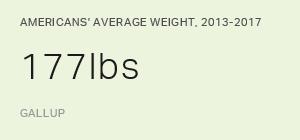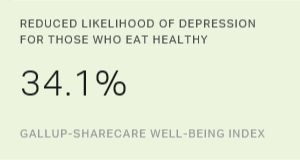Story Highlights
- Less than half of U.S. adults pay attention to menu nutrition labels
- A majority of Americans pay attention to labels on food packages
- Women, college grads, wealthier adults more likely to read labels
WASHINGTON, D.C. -- Despite recent federal Food and Drug Administration rules mandating that U.S. restaurants post nutritional information for menu items, Americans are no more likely to peruse this type of information now than they were five years ago. Today, less than half of Americans (45%) say they pay "a great deal" (16%) or "a fair amount" (29%) of attention to nutrition details at restaurants, similar to the 43% found in 2013.
| Great deal/Fair amount | Not much | None at all | |||||||||||||||||||||||||||||||||||||||||||||||||||||||||||||||||||||||||||||||||||||||||||||||||
|---|---|---|---|---|---|---|---|---|---|---|---|---|---|---|---|---|---|---|---|---|---|---|---|---|---|---|---|---|---|---|---|---|---|---|---|---|---|---|---|---|---|---|---|---|---|---|---|---|---|---|---|---|---|---|---|---|---|---|---|---|---|---|---|---|---|---|---|---|---|---|---|---|---|---|---|---|---|---|---|---|---|---|---|---|---|---|---|---|---|---|---|---|---|---|---|---|---|---|---|
| % | % | % | |||||||||||||||||||||||||||||||||||||||||||||||||||||||||||||||||||||||||||||||||||||||||||||||||
| 2018 Jul 1-11 | 45 | 31 | 23 | ||||||||||||||||||||||||||||||||||||||||||||||||||||||||||||||||||||||||||||||||||||||||||||||||
| 2013 Jul 10-14 | 43 | 26 | 29 | ||||||||||||||||||||||||||||||||||||||||||||||||||||||||||||||||||||||||||||||||||||||||||||||||
| Gallup | |||||||||||||||||||||||||||||||||||||||||||||||||||||||||||||||||||||||||||||||||||||||||||||||||||
Though the national menu labeling policy just took effect in May, New York City passed a calorie count law for restaurants in 2006, and California became the first state to pass such a law in 2008. Since then, other states and municipalities have followed suit -- though similar legislation has stalled in many local governments.
About three in 10 Americans say they do not pay much attention to nutritional information at restaurants (31%), while 23% pay no attention at all.
This could change given the new federal regulations, as more Americans will see the labels as they dine out this year and in the future.
Americans More Likely to Read Nutrition Labels on Food Packages
Though a majority of U.S. adults don't pay attention to nutritional information when they dine out, seven in 10 say they pay a great deal (32%) or fair amount (38%) of attention to nutrition labels on food packages. However, most Americans became accustomed to nutrition labels on food packaging in the early 1990s, with the passage of the Nutrition Labeling and Education Act -- so their greater attention to nutritional information on food packaging compared with that on restaurant menus may be related to the length of time this information has been available.
Meanwhile, 21% say they don't pay much attention to package labels, and 9% don't pay any attention to them at all. These figures are similar to what Gallup found in 2013 when the question was last asked.
| Great deal/Fair amount | Not much | None at all | |||||||||||||||||||||||||||||||||||||||||||||||||||||||||||||||||||||||||||||||||||||||||||||||||
|---|---|---|---|---|---|---|---|---|---|---|---|---|---|---|---|---|---|---|---|---|---|---|---|---|---|---|---|---|---|---|---|---|---|---|---|---|---|---|---|---|---|---|---|---|---|---|---|---|---|---|---|---|---|---|---|---|---|---|---|---|---|---|---|---|---|---|---|---|---|---|---|---|---|---|---|---|---|---|---|---|---|---|---|---|---|---|---|---|---|---|---|---|---|---|---|---|---|---|---|
| % | % | % | |||||||||||||||||||||||||||||||||||||||||||||||||||||||||||||||||||||||||||||||||||||||||||||||||
| 2018 Jul 1-11 | 70 | 21 | 9 | ||||||||||||||||||||||||||||||||||||||||||||||||||||||||||||||||||||||||||||||||||||||||||||||||
| 2013 Jul 10-14 | 68 | 18 | 14 | ||||||||||||||||||||||||||||||||||||||||||||||||||||||||||||||||||||||||||||||||||||||||||||||||
| Gallup | |||||||||||||||||||||||||||||||||||||||||||||||||||||||||||||||||||||||||||||||||||||||||||||||||||
Women, College Grads and Wealthier Adults More Likely to Review Labels
Some Americans pay more attention to food labels than others do. On food packaging, nearly three in four women (74%) say they pay a great deal or fair amount of attention to nutrition labels, while a smaller majority of men (62%) report doing the same.
While a slight majority of adults aged 18 to 29 (57%) report paying attention to food package labels, at least seven in 10 adults in each older age group say they do.
One of the largest differences is seen among education groups. While 80% of college graduates note nutrition details on food packaging, 63% of those who did not graduate from college say they pay attention to such labels. And among income groups, wealthier Americans are more likely than lower-income adults to pay attention to labels.
These differences are similar for food labels at restaurants, where half of women, college graduates and wealthier Americans review menu nutrition details -- the largest percentages among each subgroup.
| On food packages | At restaurants | ||||||||||||||||||||||||||||||||||||||||||||||||||||||||||||||||||||||||||||||||||||||||||||||||||
|---|---|---|---|---|---|---|---|---|---|---|---|---|---|---|---|---|---|---|---|---|---|---|---|---|---|---|---|---|---|---|---|---|---|---|---|---|---|---|---|---|---|---|---|---|---|---|---|---|---|---|---|---|---|---|---|---|---|---|---|---|---|---|---|---|---|---|---|---|---|---|---|---|---|---|---|---|---|---|---|---|---|---|---|---|---|---|---|---|---|---|---|---|---|---|---|---|---|---|---|
| % | % | ||||||||||||||||||||||||||||||||||||||||||||||||||||||||||||||||||||||||||||||||||||||||||||||||||
| Men | 62 | 37 | |||||||||||||||||||||||||||||||||||||||||||||||||||||||||||||||||||||||||||||||||||||||||||||||||
| Women | 74 | 50 | |||||||||||||||||||||||||||||||||||||||||||||||||||||||||||||||||||||||||||||||||||||||||||||||||
| 18-29 | 57 | 35 | |||||||||||||||||||||||||||||||||||||||||||||||||||||||||||||||||||||||||||||||||||||||||||||||||
| 30-49 | 70 | 45 | |||||||||||||||||||||||||||||||||||||||||||||||||||||||||||||||||||||||||||||||||||||||||||||||||
| 50-64 | 72 | 47 | |||||||||||||||||||||||||||||||||||||||||||||||||||||||||||||||||||||||||||||||||||||||||||||||||
| 65+ | 72 | 46 | |||||||||||||||||||||||||||||||||||||||||||||||||||||||||||||||||||||||||||||||||||||||||||||||||
| College graduates | 80 | 50 | |||||||||||||||||||||||||||||||||||||||||||||||||||||||||||||||||||||||||||||||||||||||||||||||||
| College nongraduates | 63 | 41 | |||||||||||||||||||||||||||||||||||||||||||||||||||||||||||||||||||||||||||||||||||||||||||||||||
| <$30,000 in household income | 63 | 41 | |||||||||||||||||||||||||||||||||||||||||||||||||||||||||||||||||||||||||||||||||||||||||||||||||
| $30,000-<$75,000 in household income | 67 | 41 | |||||||||||||||||||||||||||||||||||||||||||||||||||||||||||||||||||||||||||||||||||||||||||||||||
| $75,000+ in household income | 75 | 49 | |||||||||||||||||||||||||||||||||||||||||||||||||||||||||||||||||||||||||||||||||||||||||||||||||
| Note: Figures represent aggregated data from 2013 and 2018 | |||||||||||||||||||||||||||||||||||||||||||||||||||||||||||||||||||||||||||||||||||||||||||||||||||
| Gallup | |||||||||||||||||||||||||||||||||||||||||||||||||||||||||||||||||||||||||||||||||||||||||||||||||||
Bottom Line
As restaurants acclimate to new federal regulations on menu labeling, diners may start paying more attention to an establishment's nutritional information. Since a sizable minority of Americans currently report paying attention to nutrition labels at restaurants, the new rules could push the percentage who read them past the majority level.
Many U.S. adults currently review food packaging labels, which became required for food distributors in the early 1990s -- so the habit of checking nutritional values may become more commonplace in restaurants over time.
Certain groups outpace others when it comes to reviewing nutritional information, but this may partly reflect demographic differences. Many college students, for example, are required to take courses in which nutrition is part of the curriculum, or they may be exposed to more nutritional information in their general education. Meanwhile, lower-income Americans may pay more attention to other details when shopping for food, such as bulk size or price, than they pay to nutrition labels.
Survey Methods
Results for this Gallup poll are based on telephone interviews conducted July 1-11, 2018, with a random sample of 1,033 adults, aged 18 and older, living in all 50 U.S. states and the District of Columbia. For results based on the total sample of national adults, the margin of sampling error is ±4 percentage points at the 95% confidence level. All reported margins of sampling error include computed design effects for weighting.
Each sample of national adults includes a minimum quota of 70% cellphone respondents and 30% landline respondents, with additional minimum quotas by time zone within region. Landline and cellular telephone numbers are selected using random-digit-dial methods.
View survey methodology, complete question responses and trends.
Learn more about how the Gallup Poll Social Series works.




